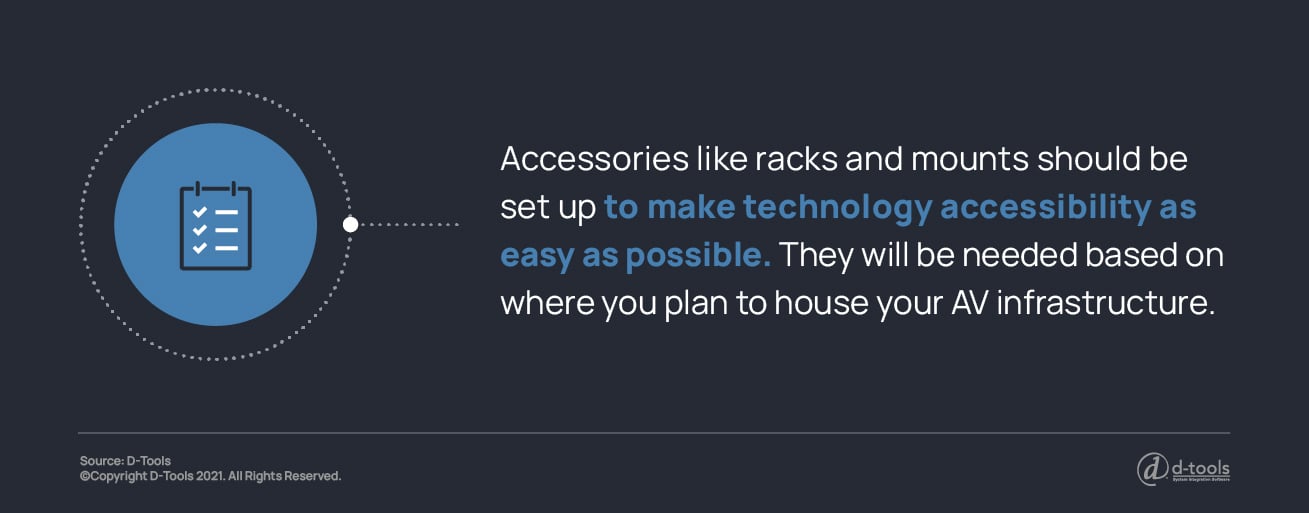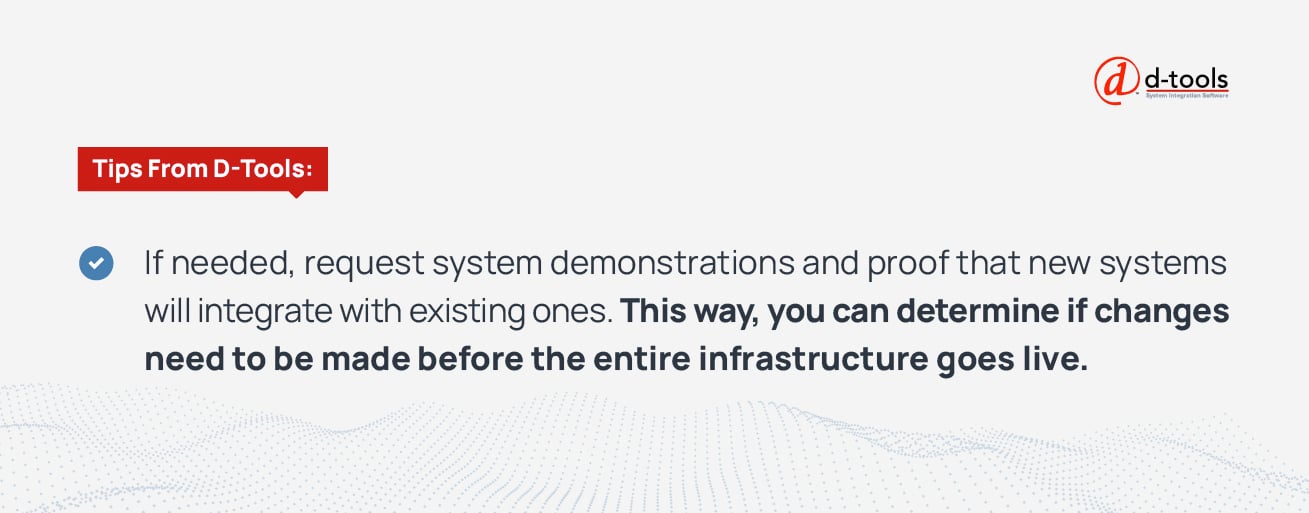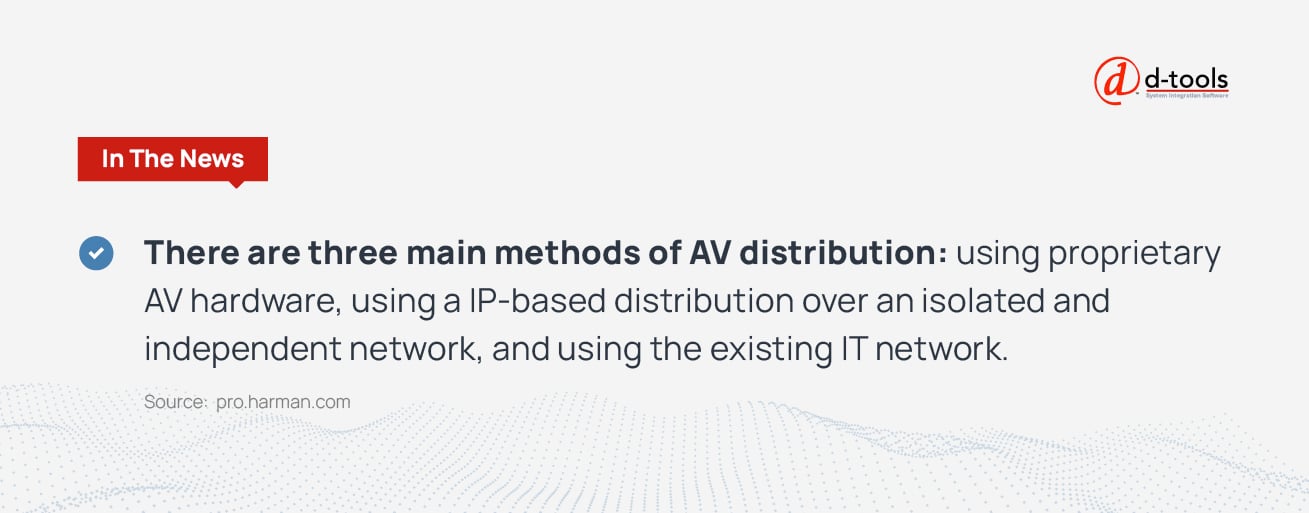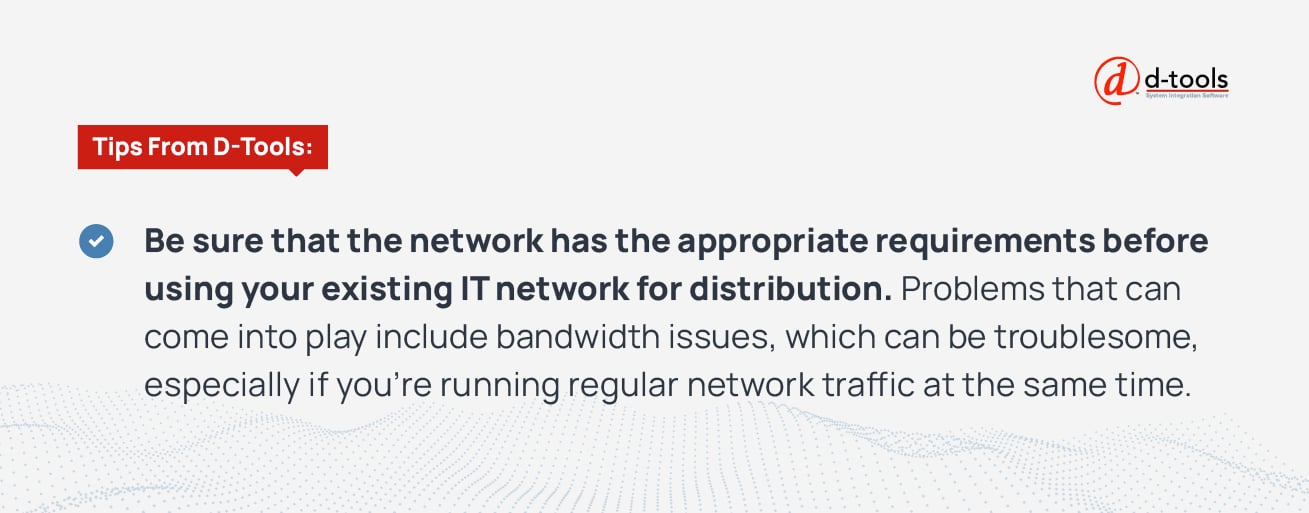Communication and collaboration are two major components to success in any organization. Most of the time, this is made possible through the use of some audio/visual system, whether it be a simple connection from a laptop to a monitor or something far more complex while sharing space with a company’s network.
More and more companies are relying on professional AV technology as they’re starting to see just how beneficial it can be for their specific needs. Some of the industries that continue to integrate AV usage include corporations, education, entertainment, government and military, among many more.

According to the AV Sales Index published by AVIXA, the Audiovisual and Integrated Experience Association, 2021 has shown continued growth in sales for the professional AV industry, with July 2021 being the second-highest number since the beginning of the pandemic. As AV technology continues to trend upward, it’s helpful to understand how to optimize AV infrastructure, AV hardware, and the various components involved.
Unlike other types of systems, there is no one right way to set up an AV infrastructure. Read on for five tips to help you successfully implement an AV infrastructure that will be the most useful for the application.
1. Understand the Components: What Is AV Infrastructure?
There are many different pathways you can take to a successful AV setup or infrastructure. It’s a complicated set of connections that can be configured with various interacting components. Some of the commonly used components of AV hardware include:
Cables
Cables transfer information between all of the devices within the AV infrastructure, including audio, lighting, video, or other types of data devices. Cables can be analog, HDMI, and fiber optic, depending on the type of AV infrastructure you set up.
Displays
Used for videos and other visuals, displays come in a range of sizes, with many different features. Some types include LCD, LED, projector, and touchscreen.
Power Management
Power management refers to the equipment needed to make sure the AV infrastructure runs smoothly and safely. This includes power cords, cooling solutions, UPS devices, surge suppression, and power distribution.
Connections
Various connectors and adapters are used to integrate all of the different components and devices within the infrastructure.
Audio
Audio equipment usually consists of speakers, amps, microphones, and more.microphones.The number and type needed will vary based on an organization’s needs.
Accessories
Other accessories, including racks and mounts, will be needed based on where you plan to house your AV infrastructure. These should be set up to make technology accessibility as easy as possible. You’ll also require panels, plates, and inserts to make the finished AV infrastructure look visually appealing and organized.

2. Have a Clear Understanding of Budget and System Limitations
Before beginning to install any AV systems, you must have a clear understanding of what the organization’s needs are, and what the systems must be able to do. Assess your challenges early to avoid surprises later in your infrastructure planning. Create scope of work. Be aware of the limitations your installed infrastructure may have, and gain a strong knowledge of how your new technology will function before it’s ordered and set up.
Planning your list of purchases and establishing a realistic budget will ensure the AV infrastructure doesn’t grow beyond your original vision. Make sure to involve key stakeholders early on in the project to know their expectations and ensure their needs are met throughout the planning process.

Have a clear understanding of exactly how the investment will lead to an increase in business or knowledge transfer within the organization. Set clear expectations for system performance and be sure to revisit them frequently to ensure expectations are being met.
If needed, request system demonstrations and proof that new systems will integrate with existing ones if applicable. This way, you can determine if changes need to be made before the entire infrastructure goes live.
Doing all of these things early on in the project gives you a greater chance of saving money, meeting expectations, and saving time overall while you design and implement your AV infrastructure.
3. Assess Electrical Needs
Whether you’re installing new equipment, building new construction, or renovating an existing building, be sure to assess the electrical capacity of your location to ensure your new AV infrastructure aligns. When necessary, hire a professional electrician to audit the space to make sure you don’t overlook important aspects that could hinder infrastructure performance, such as not enough electrical sockets, sockets in the wrong place, or an overall lack of electrical power to meet AV infrastructure needs.
4. Choose a Method of Distribution
Determine what type of distribution suits the AV infrastructure you seek to set up. Distribution refers to the ways in which the AV signals will be processed.

There are three main methods of AV distribution. These methods can be combined and used together in different areas of the AV infrastructure depending on what makes the most sense between specific components.
Understanding how each one works and what it’s best used for will help you design a usable infrastructure, and make the entire process seem a lot less overwhelming.
Proprietary AV Hardware
Using proprietary AV hardware is considered the most traditional way to go. This is standard analog AV distribution, which relies on signals that are sent through physical wiring from their initial source to the final destination. If there is a need for multiple sources to go to multiple destinations, a matrix switch would be used, which allows you to set up multiple pathways within the wiring.
This traditional and standard approach can also be replicated in the digital world, but by using wireless signals and fiber cables instead of regular wiring. The concept remains the same but will require a digital switcher and possibly a digital signal processor, depending on how the infrastructure is set up.
Local-Area Network(LAN)
Using an IP-based distribution over a LAN is another method to consider to create a useful AV infrastructure. This requires the use of standard IP networking equipment, such as network switches and routers, meaning a physical AV routing device isn’t necessary.
In this method, depending on how the networking is set up, the entire distribution can run from one switch with all devices connecting to it, or there can be a number of switches. The method in which the distribution works with the AV hardware can also vary. The network distribution can be built into an AV port on an actual device, or send AV signals to the network.
Using this method still keeps the infrastructure separate from other parts of the IT network that can be used for other things. This can be desirable due to either technical reasons, or simply to keep it separate from Internet access. This separation can also help eliminate traffic and bandwidth issues. Some IT departments might prefer to keep the two separate for other reasons.
Existing Enterprise Network
Another option for your AV infrastructure is to use your existing IT network for distribution. Using this method is simpler because the network is already there, as well as much of the connectivity needed for anything you might need in the future.

Before you go this route, though, you must be sure that the network has the appropriate requirements, and adjust if needed. Problems that can come into play include bandwidth issues, which can be troublesome, especially if you’re running regular network traffic at the same time.
When it comes down to it, the distribution method you choose will ultimately depend on the project’s specific needs and may vary depending on the specific application. Factors including environmental, managerial, and physical will also help you decide.
5. Attend Industry Events
There are various industry events and tradeshows you can attend to diversify your AV infrastructure knowledge. In addition, you can choose to take online training and earn certifications to increase your confidence in installing and maintaining your organization’s AV infrastructure.
There are also industry organizations, such as InfoComm International, which offer education, training, and networking, as well as an annual conference for anyone interested in learning more about the AV industry.
Implementing AV infrastructure can be overwhelming, but D-Tools’ software can add efficiency to your processes, by leveraging an extensive and integrated product library with vital information needed for your projects to find out how, request a demo today.


